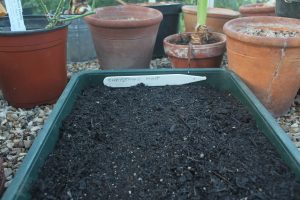Victorian gardeners ‘forced’ mint for Christmas for garnish, adding to roast vegetables during and after cooking and at the same time took the opportunity to repot their pots of mint. Pot grown mint should be divided and re-potted every couple of years. Growing in pots preferable because it can spread and become a weed; if you grow several different cultivars close together, the roots intertwine and the flavour becomes ‘muddied’. Mint in pots soon becomes ‘pot bound’ when the compost becomes full of roots, leaving a gap between the side of the pot and the root ball. When you water, it just pours through the gap. This is what you do. Cut back the foliage so it is 5cm or so above the compost for ease of handling. Put a layer of multipurpose or multipurpose with added John Innes compost (both peat free) in the base of a large seed tray to about 1/3 its depth. Knock the root ball from the pot, take an old saw or kitchen knife and saw the root ball in half, vertically across the centre from top to bottom, cut about 2.5cm off the base. Tease out the roots of one half and repot and label ready for next year, tease out the thicker roots of the other half of the root ball, cut them into sections from 10 -20cm long, lay them on the surface of the compost in the seed tray, with a 2-3 cm between each one, cover with compost, firm gently then take them to the greenhouse and water with tepid water. Don’t forget to label the tray with the plant name and date. Do this from the middle to the end of the month and you will have fresh mint for Christmas.

Sow sweet peas in a cool greenhouse. Put the seeds between two layers of kitchen towel on an old dinner plate. Dampen the towel, drain off excess water and sow those that start to swell or sprout, which usually takes 48 hours. Leave any others a little longer; those that don’t swell and germinate can be composted. Sow the living seeds individually into ‘Root Trainers’ or 9cm (3in) pots of seed compost or five to seven seeds to a 13cm (5in) pot, with the seeds spaced 2-3cm (¾-1¼in) apart, then cover the seeds with 1cm (½in) of compost. Water in gently, cover the pots with clear polythene then put them in a propagator at about 15°C (59°F). Remove the covering after they have germinated and overwinter the young plants in a cold frame or unheated greenhouse. If not sown individually, transplant single seedlings into 9cm (3in) pots once they have reached about 3.5 cm (1½in) tall.
Sow trays, pots, old growing bags or borders with ‘cut and come again crops’ to harvest through autumn and into winter. Try land cress, pak choi, mizuna and mibuna greens plus lettuce, lamb’s lettuce, chicory and radish. You can also use what’s left in the packets from earlier brassica sowings and harvest them earlier as microgreens.
Bring pelargoniums into the greenhouse before the first frosts. Cut back the main stems to within a few inches of the base and keep them slightly moist over winter, (more are killed by overwatering than under watering) maintaining a temperature of around 10°C (50°F) bring in tender Fuchsias and marguerites, too. Treat plants like Fuchsias, cacti and succulents with Vine weevil biological control nematodes before bringing them into the greenhouse.
Happy gardening. Matt


